University Assignment: Personal Footprint and Sustainability Analysis
VerifiedAdded on 2023/03/20
|9
|2086
|88
Homework Assignment
AI Summary
This assignment presents a comprehensive sustainability analysis, starting with the calculation of a personal ecological footprint and carbon footprint, interpreting the results to identify unsustainable aspects of the student's lifestyle. It then explores potential solutions in areas such as city living, energy consumption, food choices, and population impact. The assignment further examines the sustainability of an air conditioner, analyzing its materials, manufacturing process, energy consumption, and waste hierarchy. The application of the cradle-to-cradle design protocol is considered for improving the product's sustainability. Finally, it assesses the corporate social responsibility of the LG company, identifying key stakeholders and suggesting CSR initiatives, particularly for underprivileged groups, while also addressing the challenges in changing consumption patterns due to rising temperatures. The assignment incorporates relevant references to support its findings and recommendations.
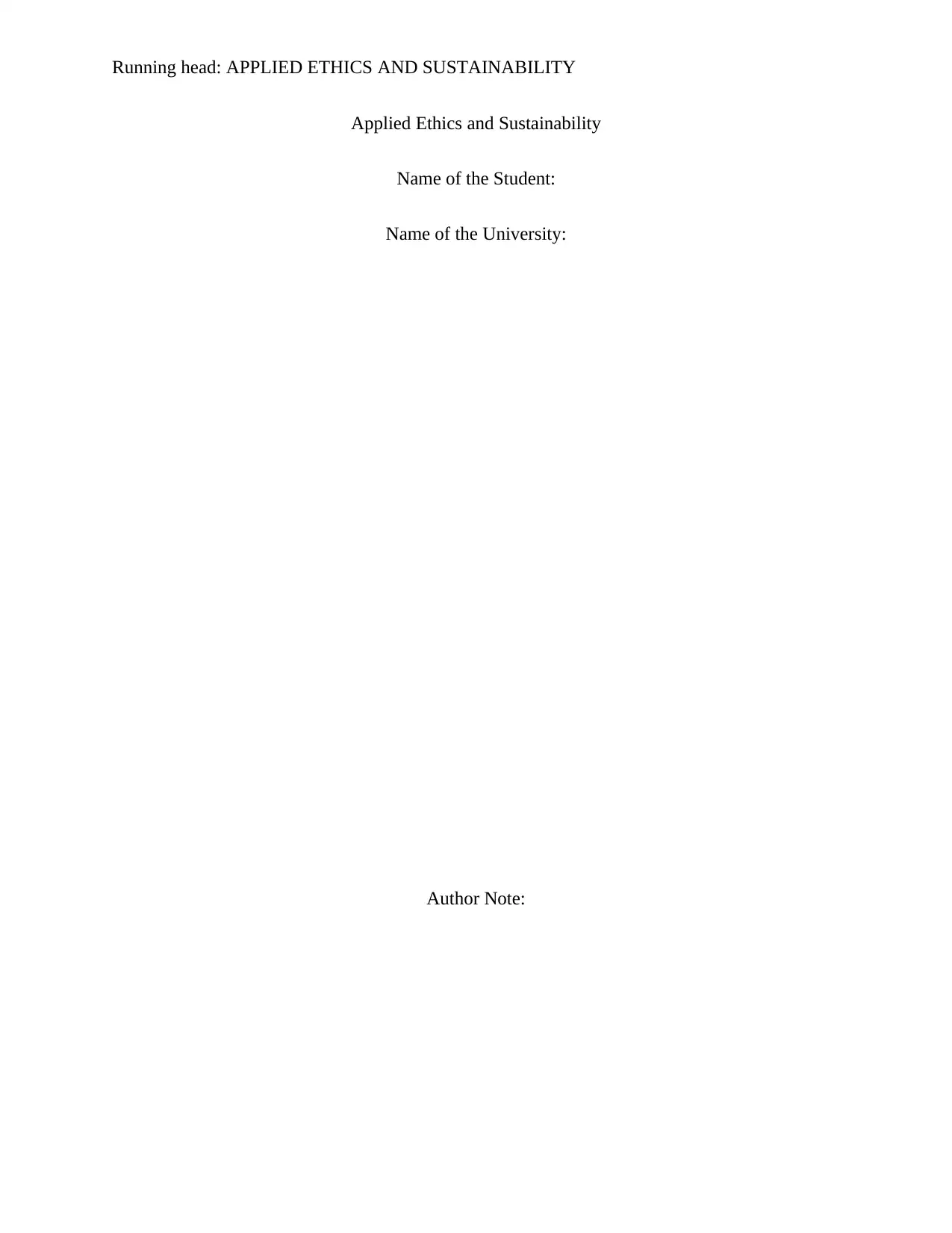
Running head: APPLIED ETHICS AND SUSTAINABILITY
Applied Ethics and Sustainability
Name of the Student:
Name of the University:
Author Note:
Applied Ethics and Sustainability
Name of the Student:
Name of the University:
Author Note:
Paraphrase This Document
Need a fresh take? Get an instant paraphrase of this document with our AI Paraphraser
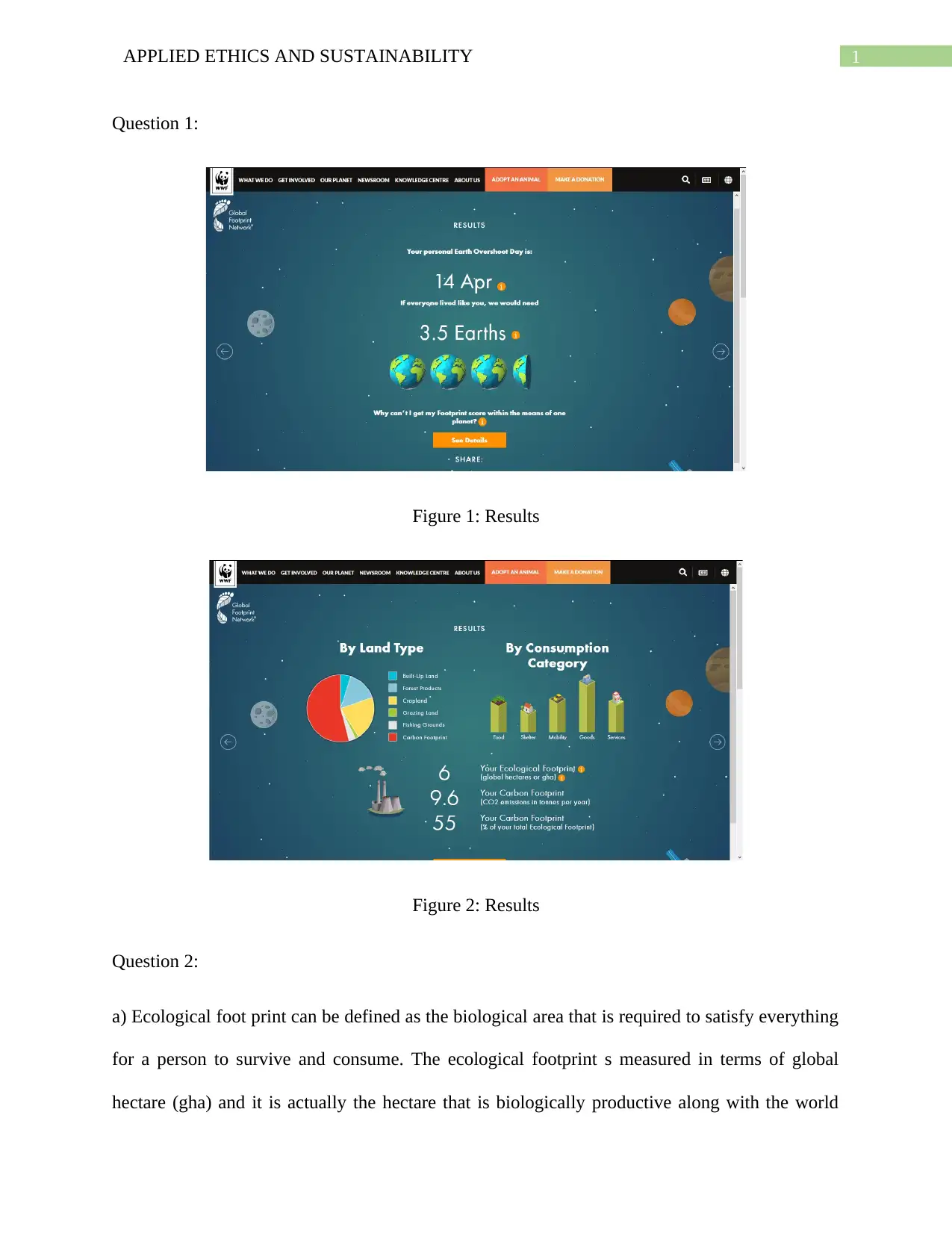
1APPLIED ETHICS AND SUSTAINABILITY
Question 1:
Figure 1: Results
Figure 2: Results
Question 2:
a) Ecological foot print can be defined as the biological area that is required to satisfy everything
for a person to survive and consume. The ecological footprint s measured in terms of global
hectare (gha) and it is actually the hectare that is biologically productive along with the world
Question 1:
Figure 1: Results
Figure 2: Results
Question 2:
a) Ecological foot print can be defined as the biological area that is required to satisfy everything
for a person to survive and consume. The ecological footprint s measured in terms of global
hectare (gha) and it is actually the hectare that is biologically productive along with the world
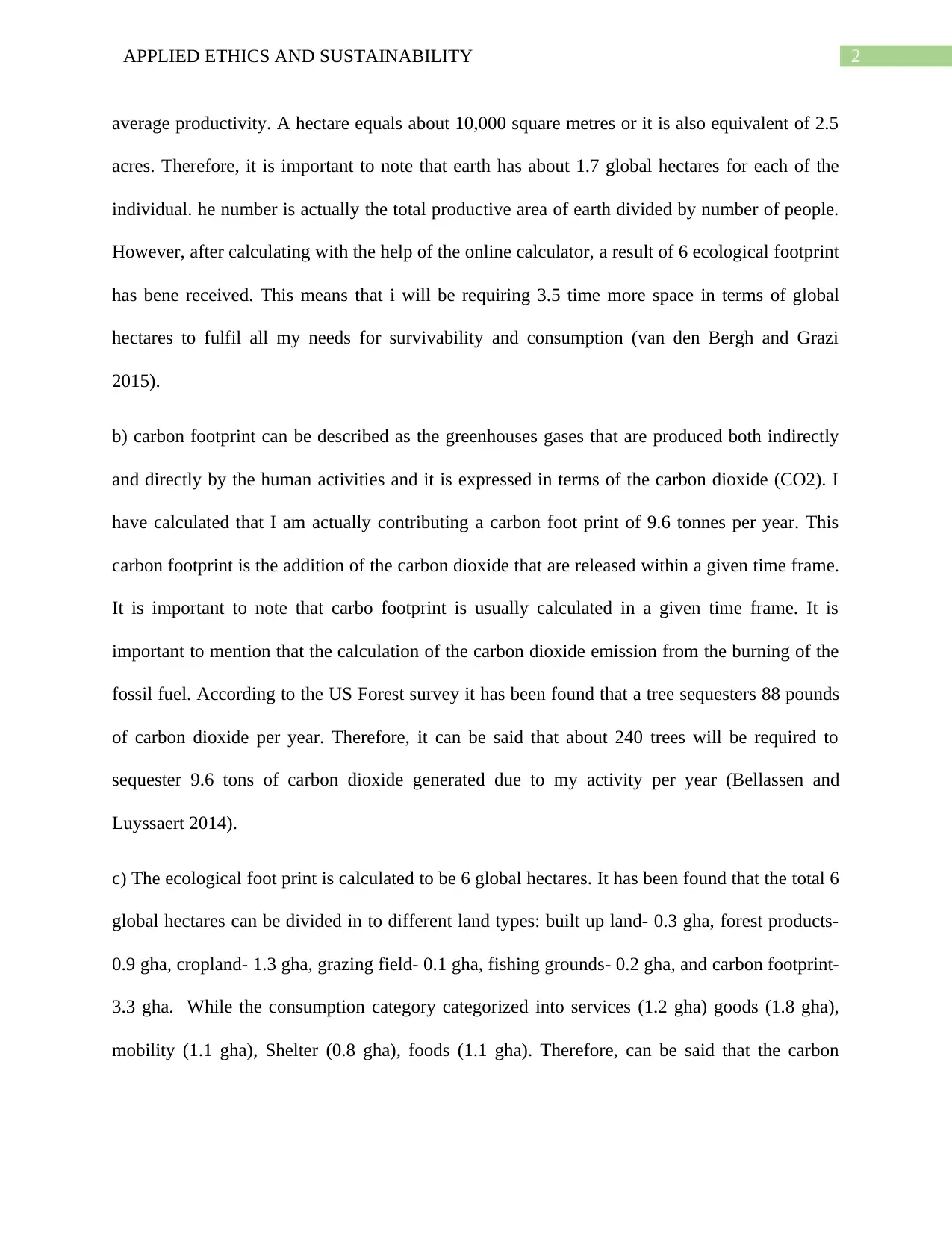
2APPLIED ETHICS AND SUSTAINABILITY
average productivity. A hectare equals about 10,000 square metres or it is also equivalent of 2.5
acres. Therefore, it is important to note that earth has about 1.7 global hectares for each of the
individual. he number is actually the total productive area of earth divided by number of people.
However, after calculating with the help of the online calculator, a result of 6 ecological footprint
has bene received. This means that i will be requiring 3.5 time more space in terms of global
hectares to fulfil all my needs for survivability and consumption (van den Bergh and Grazi
2015).
b) carbon footprint can be described as the greenhouses gases that are produced both indirectly
and directly by the human activities and it is expressed in terms of the carbon dioxide (CO2). I
have calculated that I am actually contributing a carbon foot print of 9.6 tonnes per year. This
carbon footprint is the addition of the carbon dioxide that are released within a given time frame.
It is important to note that carbo footprint is usually calculated in a given time frame. It is
important to mention that the calculation of the carbon dioxide emission from the burning of the
fossil fuel. According to the US Forest survey it has been found that a tree sequesters 88 pounds
of carbon dioxide per year. Therefore, it can be said that about 240 trees will be required to
sequester 9.6 tons of carbon dioxide generated due to my activity per year (Bellassen and
Luyssaert 2014).
c) The ecological foot print is calculated to be 6 global hectares. It has been found that the total 6
global hectares can be divided in to different land types: built up land- 0.3 gha, forest products-
0.9 gha, cropland- 1.3 gha, grazing field- 0.1 gha, fishing grounds- 0.2 gha, and carbon footprint-
3.3 gha. While the consumption category categorized into services (1.2 gha) goods (1.8 gha),
mobility (1.1 gha), Shelter (0.8 gha), foods (1.1 gha). Therefore, can be said that the carbon
average productivity. A hectare equals about 10,000 square metres or it is also equivalent of 2.5
acres. Therefore, it is important to note that earth has about 1.7 global hectares for each of the
individual. he number is actually the total productive area of earth divided by number of people.
However, after calculating with the help of the online calculator, a result of 6 ecological footprint
has bene received. This means that i will be requiring 3.5 time more space in terms of global
hectares to fulfil all my needs for survivability and consumption (van den Bergh and Grazi
2015).
b) carbon footprint can be described as the greenhouses gases that are produced both indirectly
and directly by the human activities and it is expressed in terms of the carbon dioxide (CO2). I
have calculated that I am actually contributing a carbon foot print of 9.6 tonnes per year. This
carbon footprint is the addition of the carbon dioxide that are released within a given time frame.
It is important to note that carbo footprint is usually calculated in a given time frame. It is
important to mention that the calculation of the carbon dioxide emission from the burning of the
fossil fuel. According to the US Forest survey it has been found that a tree sequesters 88 pounds
of carbon dioxide per year. Therefore, it can be said that about 240 trees will be required to
sequester 9.6 tons of carbon dioxide generated due to my activity per year (Bellassen and
Luyssaert 2014).
c) The ecological foot print is calculated to be 6 global hectares. It has been found that the total 6
global hectares can be divided in to different land types: built up land- 0.3 gha, forest products-
0.9 gha, cropland- 1.3 gha, grazing field- 0.1 gha, fishing grounds- 0.2 gha, and carbon footprint-
3.3 gha. While the consumption category categorized into services (1.2 gha) goods (1.8 gha),
mobility (1.1 gha), Shelter (0.8 gha), foods (1.1 gha). Therefore, can be said that the carbon
⊘ This is a preview!⊘
Do you want full access?
Subscribe today to unlock all pages.

Trusted by 1+ million students worldwide
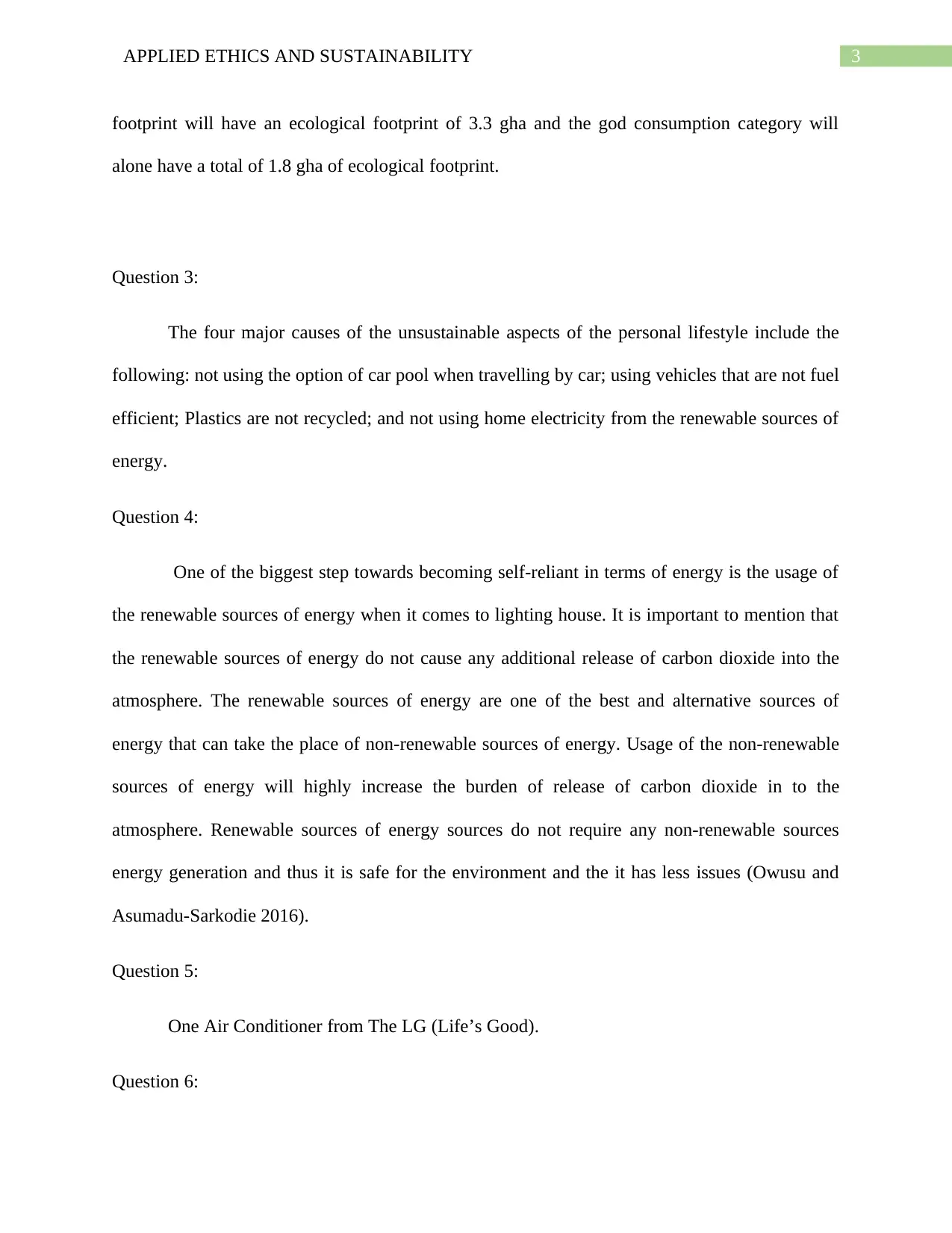
3APPLIED ETHICS AND SUSTAINABILITY
footprint will have an ecological footprint of 3.3 gha and the god consumption category will
alone have a total of 1.8 gha of ecological footprint.
Question 3:
The four major causes of the unsustainable aspects of the personal lifestyle include the
following: not using the option of car pool when travelling by car; using vehicles that are not fuel
efficient; Plastics are not recycled; and not using home electricity from the renewable sources of
energy.
Question 4:
One of the biggest step towards becoming self-reliant in terms of energy is the usage of
the renewable sources of energy when it comes to lighting house. It is important to mention that
the renewable sources of energy do not cause any additional release of carbon dioxide into the
atmosphere. The renewable sources of energy are one of the best and alternative sources of
energy that can take the place of non-renewable sources of energy. Usage of the non-renewable
sources of energy will highly increase the burden of release of carbon dioxide in to the
atmosphere. Renewable sources of energy sources do not require any non-renewable sources
energy generation and thus it is safe for the environment and the it has less issues (Owusu and
Asumadu-Sarkodie 2016).
Question 5:
One Air Conditioner from The LG (Life’s Good).
Question 6:
footprint will have an ecological footprint of 3.3 gha and the god consumption category will
alone have a total of 1.8 gha of ecological footprint.
Question 3:
The four major causes of the unsustainable aspects of the personal lifestyle include the
following: not using the option of car pool when travelling by car; using vehicles that are not fuel
efficient; Plastics are not recycled; and not using home electricity from the renewable sources of
energy.
Question 4:
One of the biggest step towards becoming self-reliant in terms of energy is the usage of
the renewable sources of energy when it comes to lighting house. It is important to mention that
the renewable sources of energy do not cause any additional release of carbon dioxide into the
atmosphere. The renewable sources of energy are one of the best and alternative sources of
energy that can take the place of non-renewable sources of energy. Usage of the non-renewable
sources of energy will highly increase the burden of release of carbon dioxide in to the
atmosphere. Renewable sources of energy sources do not require any non-renewable sources
energy generation and thus it is safe for the environment and the it has less issues (Owusu and
Asumadu-Sarkodie 2016).
Question 5:
One Air Conditioner from The LG (Life’s Good).
Question 6:
Paraphrase This Document
Need a fresh take? Get an instant paraphrase of this document with our AI Paraphraser
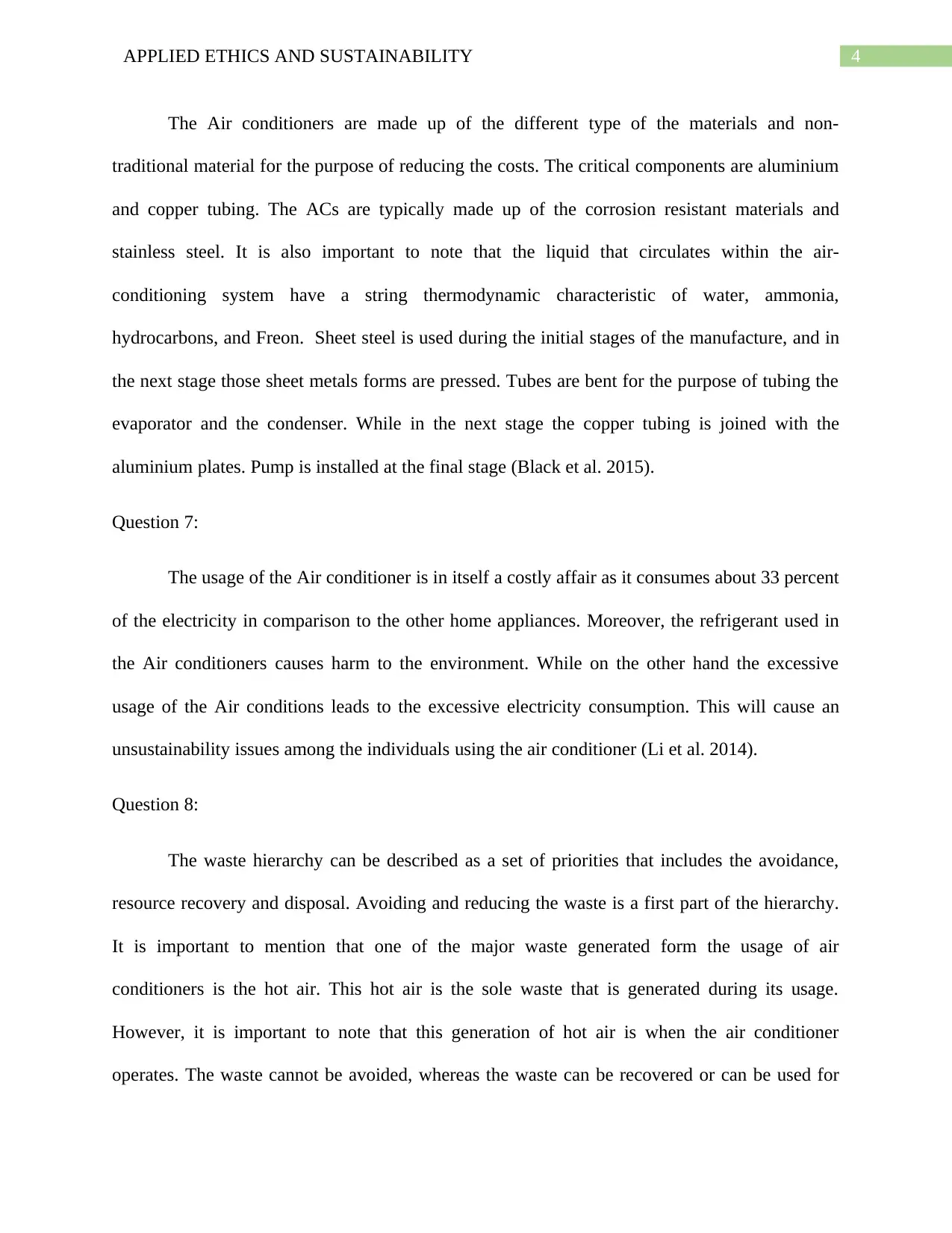
4APPLIED ETHICS AND SUSTAINABILITY
The Air conditioners are made up of the different type of the materials and non-
traditional material for the purpose of reducing the costs. The critical components are aluminium
and copper tubing. The ACs are typically made up of the corrosion resistant materials and
stainless steel. It is also important to note that the liquid that circulates within the air-
conditioning system have a string thermodynamic characteristic of water, ammonia,
hydrocarbons, and Freon. Sheet steel is used during the initial stages of the manufacture, and in
the next stage those sheet metals forms are pressed. Tubes are bent for the purpose of tubing the
evaporator and the condenser. While in the next stage the copper tubing is joined with the
aluminium plates. Pump is installed at the final stage (Black et al. 2015).
Question 7:
The usage of the Air conditioner is in itself a costly affair as it consumes about 33 percent
of the electricity in comparison to the other home appliances. Moreover, the refrigerant used in
the Air conditioners causes harm to the environment. While on the other hand the excessive
usage of the Air conditions leads to the excessive electricity consumption. This will cause an
unsustainability issues among the individuals using the air conditioner (Li et al. 2014).
Question 8:
The waste hierarchy can be described as a set of priorities that includes the avoidance,
resource recovery and disposal. Avoiding and reducing the waste is a first part of the hierarchy.
It is important to mention that one of the major waste generated form the usage of air
conditioners is the hot air. This hot air is the sole waste that is generated during its usage.
However, it is important to note that this generation of hot air is when the air conditioner
operates. The waste cannot be avoided, whereas the waste can be recovered or can be used for
The Air conditioners are made up of the different type of the materials and non-
traditional material for the purpose of reducing the costs. The critical components are aluminium
and copper tubing. The ACs are typically made up of the corrosion resistant materials and
stainless steel. It is also important to note that the liquid that circulates within the air-
conditioning system have a string thermodynamic characteristic of water, ammonia,
hydrocarbons, and Freon. Sheet steel is used during the initial stages of the manufacture, and in
the next stage those sheet metals forms are pressed. Tubes are bent for the purpose of tubing the
evaporator and the condenser. While in the next stage the copper tubing is joined with the
aluminium plates. Pump is installed at the final stage (Black et al. 2015).
Question 7:
The usage of the Air conditioner is in itself a costly affair as it consumes about 33 percent
of the electricity in comparison to the other home appliances. Moreover, the refrigerant used in
the Air conditioners causes harm to the environment. While on the other hand the excessive
usage of the Air conditions leads to the excessive electricity consumption. This will cause an
unsustainability issues among the individuals using the air conditioner (Li et al. 2014).
Question 8:
The waste hierarchy can be described as a set of priorities that includes the avoidance,
resource recovery and disposal. Avoiding and reducing the waste is a first part of the hierarchy.
It is important to mention that one of the major waste generated form the usage of air
conditioners is the hot air. This hot air is the sole waste that is generated during its usage.
However, it is important to note that this generation of hot air is when the air conditioner
operates. The waste cannot be avoided, whereas the waste can be recovered or can be used for
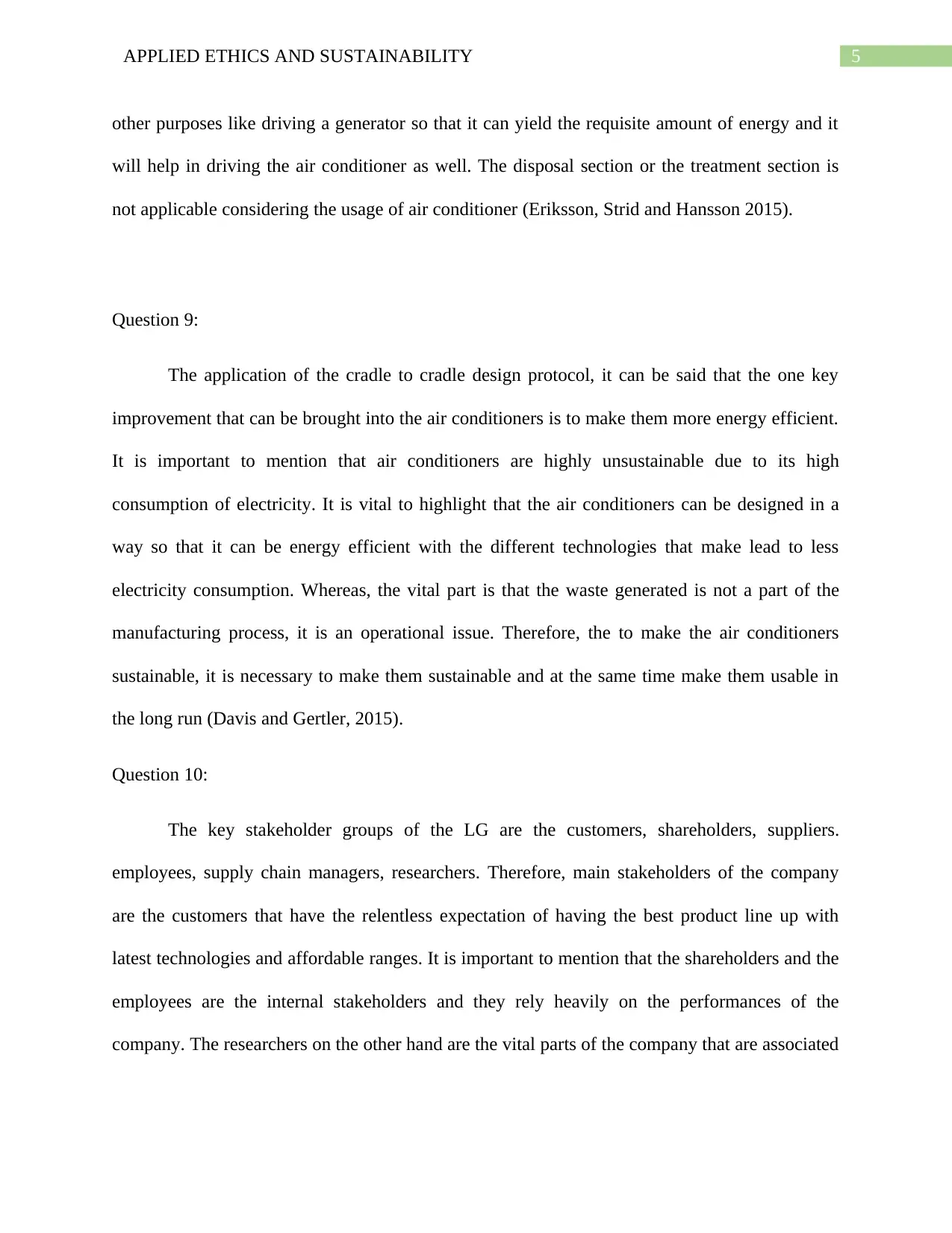
5APPLIED ETHICS AND SUSTAINABILITY
other purposes like driving a generator so that it can yield the requisite amount of energy and it
will help in driving the air conditioner as well. The disposal section or the treatment section is
not applicable considering the usage of air conditioner (Eriksson, Strid and Hansson 2015).
Question 9:
The application of the cradle to cradle design protocol, it can be said that the one key
improvement that can be brought into the air conditioners is to make them more energy efficient.
It is important to mention that air conditioners are highly unsustainable due to its high
consumption of electricity. It is vital to highlight that the air conditioners can be designed in a
way so that it can be energy efficient with the different technologies that make lead to less
electricity consumption. Whereas, the vital part is that the waste generated is not a part of the
manufacturing process, it is an operational issue. Therefore, the to make the air conditioners
sustainable, it is necessary to make them sustainable and at the same time make them usable in
the long run (Davis and Gertler, 2015).
Question 10:
The key stakeholder groups of the LG are the customers, shareholders, suppliers.
employees, supply chain managers, researchers. Therefore, main stakeholders of the company
are the customers that have the relentless expectation of having the best product line up with
latest technologies and affordable ranges. It is important to mention that the shareholders and the
employees are the internal stakeholders and they rely heavily on the performances of the
company. The researchers on the other hand are the vital parts of the company that are associated
other purposes like driving a generator so that it can yield the requisite amount of energy and it
will help in driving the air conditioner as well. The disposal section or the treatment section is
not applicable considering the usage of air conditioner (Eriksson, Strid and Hansson 2015).
Question 9:
The application of the cradle to cradle design protocol, it can be said that the one key
improvement that can be brought into the air conditioners is to make them more energy efficient.
It is important to mention that air conditioners are highly unsustainable due to its high
consumption of electricity. It is vital to highlight that the air conditioners can be designed in a
way so that it can be energy efficient with the different technologies that make lead to less
electricity consumption. Whereas, the vital part is that the waste generated is not a part of the
manufacturing process, it is an operational issue. Therefore, the to make the air conditioners
sustainable, it is necessary to make them sustainable and at the same time make them usable in
the long run (Davis and Gertler, 2015).
Question 10:
The key stakeholder groups of the LG are the customers, shareholders, suppliers.
employees, supply chain managers, researchers. Therefore, main stakeholders of the company
are the customers that have the relentless expectation of having the best product line up with
latest technologies and affordable ranges. It is important to mention that the shareholders and the
employees are the internal stakeholders and they rely heavily on the performances of the
company. The researchers on the other hand are the vital parts of the company that are associated
⊘ This is a preview!⊘
Do you want full access?
Subscribe today to unlock all pages.

Trusted by 1+ million students worldwide
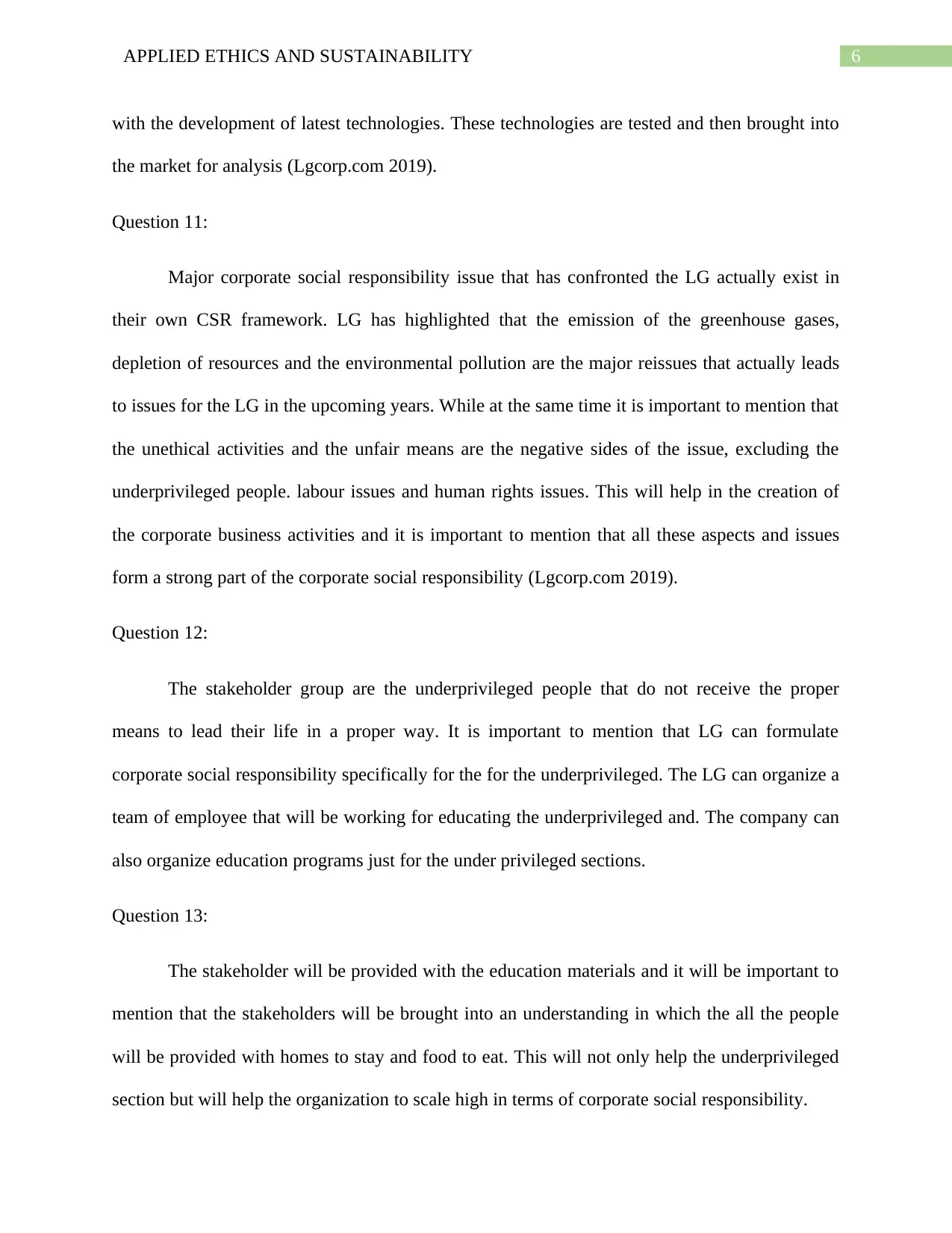
6APPLIED ETHICS AND SUSTAINABILITY
with the development of latest technologies. These technologies are tested and then brought into
the market for analysis (Lgcorp.com 2019).
Question 11:
Major corporate social responsibility issue that has confronted the LG actually exist in
their own CSR framework. LG has highlighted that the emission of the greenhouse gases,
depletion of resources and the environmental pollution are the major reissues that actually leads
to issues for the LG in the upcoming years. While at the same time it is important to mention that
the unethical activities and the unfair means are the negative sides of the issue, excluding the
underprivileged people. labour issues and human rights issues. This will help in the creation of
the corporate business activities and it is important to mention that all these aspects and issues
form a strong part of the corporate social responsibility (Lgcorp.com 2019).
Question 12:
The stakeholder group are the underprivileged people that do not receive the proper
means to lead their life in a proper way. It is important to mention that LG can formulate
corporate social responsibility specifically for the for the underprivileged. The LG can organize a
team of employee that will be working for educating the underprivileged and. The company can
also organize education programs just for the under privileged sections.
Question 13:
The stakeholder will be provided with the education materials and it will be important to
mention that the stakeholders will be brought into an understanding in which the all the people
will be provided with homes to stay and food to eat. This will not only help the underprivileged
section but will help the organization to scale high in terms of corporate social responsibility.
with the development of latest technologies. These technologies are tested and then brought into
the market for analysis (Lgcorp.com 2019).
Question 11:
Major corporate social responsibility issue that has confronted the LG actually exist in
their own CSR framework. LG has highlighted that the emission of the greenhouse gases,
depletion of resources and the environmental pollution are the major reissues that actually leads
to issues for the LG in the upcoming years. While at the same time it is important to mention that
the unethical activities and the unfair means are the negative sides of the issue, excluding the
underprivileged people. labour issues and human rights issues. This will help in the creation of
the corporate business activities and it is important to mention that all these aspects and issues
form a strong part of the corporate social responsibility (Lgcorp.com 2019).
Question 12:
The stakeholder group are the underprivileged people that do not receive the proper
means to lead their life in a proper way. It is important to mention that LG can formulate
corporate social responsibility specifically for the for the underprivileged. The LG can organize a
team of employee that will be working for educating the underprivileged and. The company can
also organize education programs just for the under privileged sections.
Question 13:
The stakeholder will be provided with the education materials and it will be important to
mention that the stakeholders will be brought into an understanding in which the all the people
will be provided with homes to stay and food to eat. This will not only help the underprivileged
section but will help the organization to scale high in terms of corporate social responsibility.
Paraphrase This Document
Need a fresh take? Get an instant paraphrase of this document with our AI Paraphraser
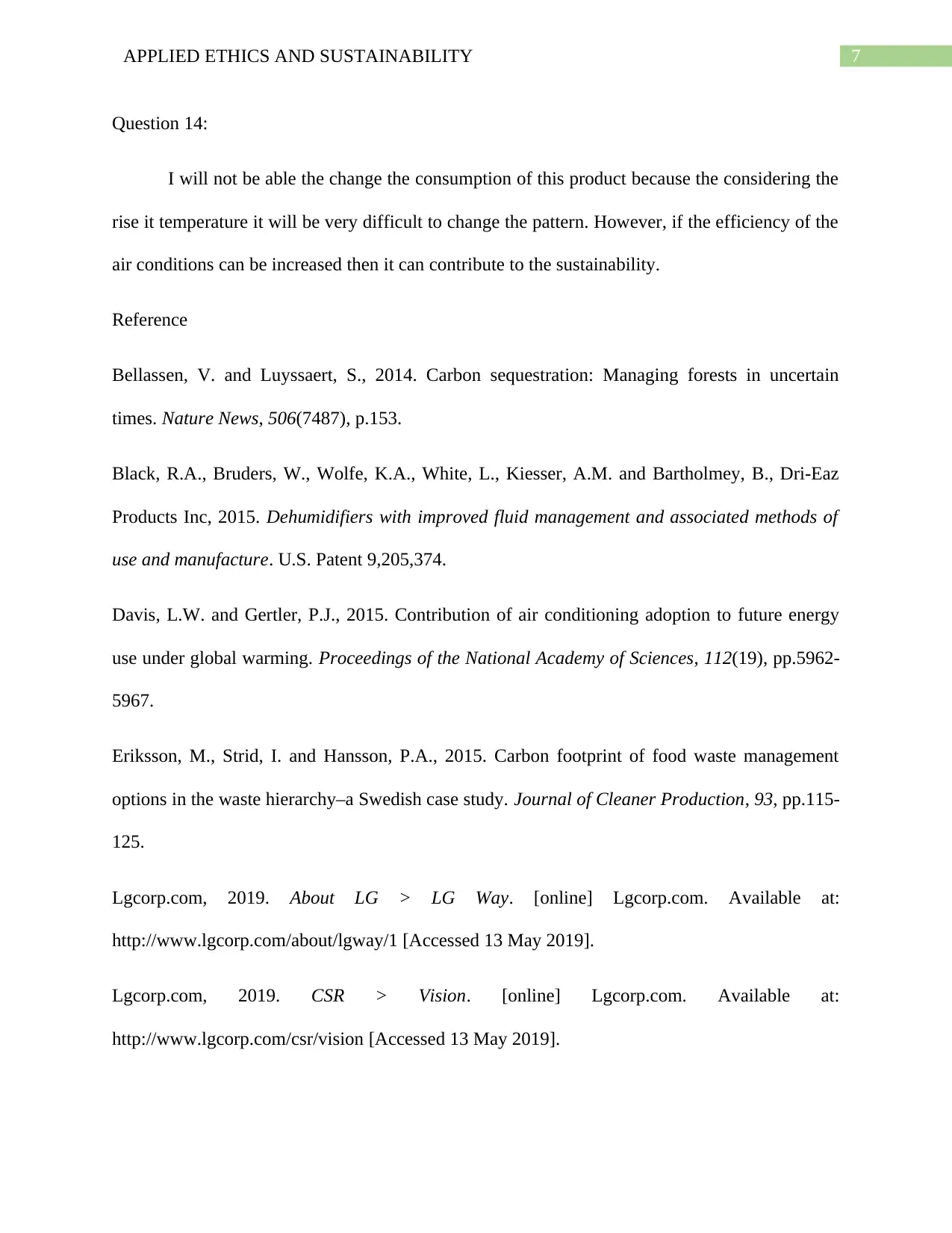
7APPLIED ETHICS AND SUSTAINABILITY
Question 14:
I will not be able the change the consumption of this product because the considering the
rise it temperature it will be very difficult to change the pattern. However, if the efficiency of the
air conditions can be increased then it can contribute to the sustainability.
Reference
Bellassen, V. and Luyssaert, S., 2014. Carbon sequestration: Managing forests in uncertain
times. Nature News, 506(7487), p.153.
Black, R.A., Bruders, W., Wolfe, K.A., White, L., Kiesser, A.M. and Bartholmey, B., Dri-Eaz
Products Inc, 2015. Dehumidifiers with improved fluid management and associated methods of
use and manufacture. U.S. Patent 9,205,374.
Davis, L.W. and Gertler, P.J., 2015. Contribution of air conditioning adoption to future energy
use under global warming. Proceedings of the National Academy of Sciences, 112(19), pp.5962-
5967.
Eriksson, M., Strid, I. and Hansson, P.A., 2015. Carbon footprint of food waste management
options in the waste hierarchy–a Swedish case study. Journal of Cleaner Production, 93, pp.115-
125.
Lgcorp.com, 2019. About LG > LG Way. [online] Lgcorp.com. Available at:
http://www.lgcorp.com/about/lgway/1 [Accessed 13 May 2019].
Lgcorp.com, 2019. CSR > Vision. [online] Lgcorp.com. Available at:
http://www.lgcorp.com/csr/vision [Accessed 13 May 2019].
Question 14:
I will not be able the change the consumption of this product because the considering the
rise it temperature it will be very difficult to change the pattern. However, if the efficiency of the
air conditions can be increased then it can contribute to the sustainability.
Reference
Bellassen, V. and Luyssaert, S., 2014. Carbon sequestration: Managing forests in uncertain
times. Nature News, 506(7487), p.153.
Black, R.A., Bruders, W., Wolfe, K.A., White, L., Kiesser, A.M. and Bartholmey, B., Dri-Eaz
Products Inc, 2015. Dehumidifiers with improved fluid management and associated methods of
use and manufacture. U.S. Patent 9,205,374.
Davis, L.W. and Gertler, P.J., 2015. Contribution of air conditioning adoption to future energy
use under global warming. Proceedings of the National Academy of Sciences, 112(19), pp.5962-
5967.
Eriksson, M., Strid, I. and Hansson, P.A., 2015. Carbon footprint of food waste management
options in the waste hierarchy–a Swedish case study. Journal of Cleaner Production, 93, pp.115-
125.
Lgcorp.com, 2019. About LG > LG Way. [online] Lgcorp.com. Available at:
http://www.lgcorp.com/about/lgway/1 [Accessed 13 May 2019].
Lgcorp.com, 2019. CSR > Vision. [online] Lgcorp.com. Available at:
http://www.lgcorp.com/csr/vision [Accessed 13 May 2019].
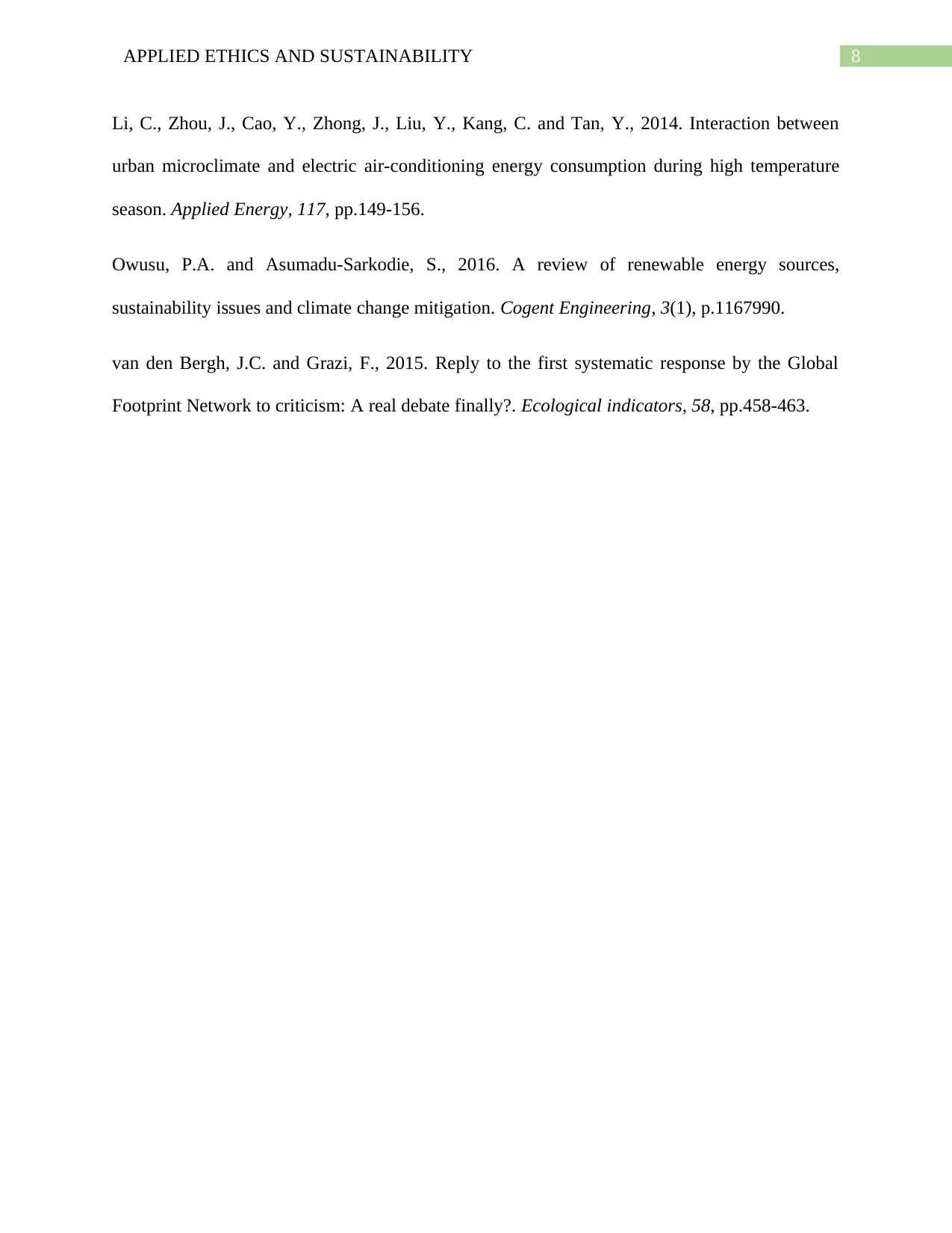
8APPLIED ETHICS AND SUSTAINABILITY
Li, C., Zhou, J., Cao, Y., Zhong, J., Liu, Y., Kang, C. and Tan, Y., 2014. Interaction between
urban microclimate and electric air-conditioning energy consumption during high temperature
season. Applied Energy, 117, pp.149-156.
Owusu, P.A. and Asumadu-Sarkodie, S., 2016. A review of renewable energy sources,
sustainability issues and climate change mitigation. Cogent Engineering, 3(1), p.1167990.
van den Bergh, J.C. and Grazi, F., 2015. Reply to the first systematic response by the Global
Footprint Network to criticism: A real debate finally?. Ecological indicators, 58, pp.458-463.
Li, C., Zhou, J., Cao, Y., Zhong, J., Liu, Y., Kang, C. and Tan, Y., 2014. Interaction between
urban microclimate and electric air-conditioning energy consumption during high temperature
season. Applied Energy, 117, pp.149-156.
Owusu, P.A. and Asumadu-Sarkodie, S., 2016. A review of renewable energy sources,
sustainability issues and climate change mitigation. Cogent Engineering, 3(1), p.1167990.
van den Bergh, J.C. and Grazi, F., 2015. Reply to the first systematic response by the Global
Footprint Network to criticism: A real debate finally?. Ecological indicators, 58, pp.458-463.
⊘ This is a preview!⊘
Do you want full access?
Subscribe today to unlock all pages.

Trusted by 1+ million students worldwide
1 out of 9
Related Documents
Your All-in-One AI-Powered Toolkit for Academic Success.
+13062052269
info@desklib.com
Available 24*7 on WhatsApp / Email
![[object Object]](/_next/static/media/star-bottom.7253800d.svg)
Unlock your academic potential
Copyright © 2020–2025 A2Z Services. All Rights Reserved. Developed and managed by ZUCOL.





